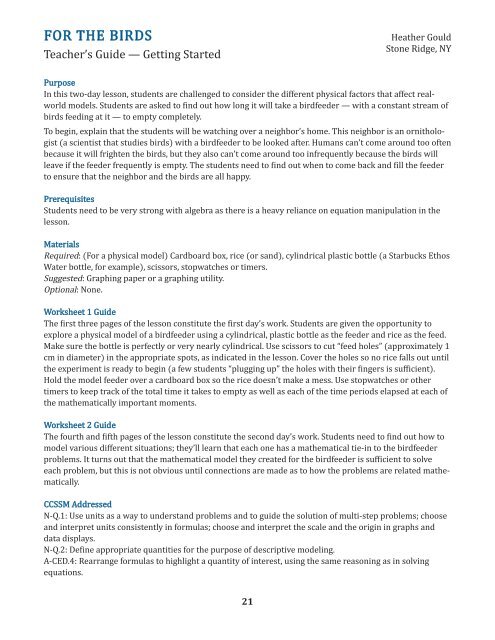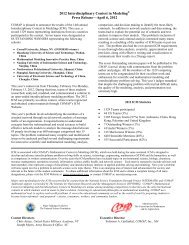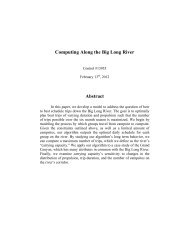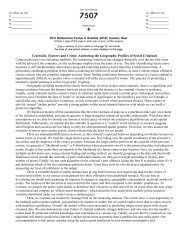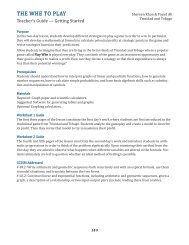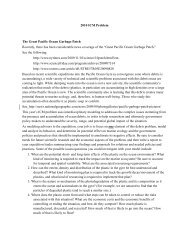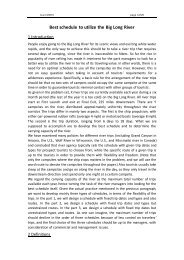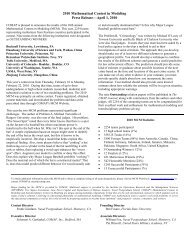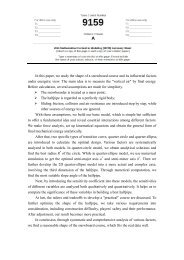FOR THE BIRDS
FOR THE BIRDS
FOR THE BIRDS
Create successful ePaper yourself
Turn your PDF publications into a flip-book with our unique Google optimized e-Paper software.
<strong>FOR</strong> <strong>THE</strong> <strong>BIRDS</strong><br />
Teacher’s Guide — Getting Started<br />
Heather Gould<br />
Stone Ridge, NY<br />
Purpose<br />
In this two-day lesson, students are challenged to consider the different physical factors that affect realworld<br />
models. Students are asked to find out how long it will take a birdfeeder — with a constant stream of<br />
birds feeding at it — to empty completely.<br />
To begin, explain that the students will be watching over a neighbor’s home. This neighbor is an ornithologist<br />
(a scientist that studies birds) with a birdfeeder to be looked after. Humans can’t come around too often<br />
because it will frighten the birds, but they also can’t come around too infrequently because the birds will<br />
leave if the feeder frequently is empty. The students need to find out when to come back and fill the feeder<br />
to ensure that the neighbor and the birds are all happy.<br />
Prerequisites<br />
Students need to be very strong with algebra as there is a heavy reliance on equation manipulation in the<br />
lesson.<br />
Materials<br />
Required: (For a physical model) Cardboard box, rice (or sand), cylindrical plastic bottle (a Starbucks Ethos<br />
Water bottle, for example), scissors, stopwatches or timers.<br />
Suggested: Graphing paper or a graphing utility.<br />
Optional: None.<br />
Worksheet 1 Guide<br />
The first three pages of the lesson constitute the first day’s work. Students are given the opportunity to<br />
explore a physical model of a birdfeeder using a cylindrical, plastic bottle as the feeder and rice as the feed.<br />
Make sure the bottle is perfectly or very nearly cylindrical. Use scissors to cut “feed holes” (approximately 1<br />
cm in diameter) in the appropriate spots, as indicated in the lesson. Cover the holes so no rice falls out until<br />
the experiment is ready to begin (a few students “plugging up” the holes with their fingers is sufficient).<br />
Hold the model feeder over a cardboard box so the rice doesn’t make a mess. Use stopwatches or other<br />
timers to keep track of the total time it takes to empty as well as each of the time periods elapsed at each of<br />
the mathematically important moments.<br />
Worksheet 2 Guide<br />
The fourth and fifth pages of the lesson constitute the second day’s work. Students need to find out how to<br />
model various different situations; they’ll learn that each one has a mathematical tie-in to the birdfeeder<br />
problems. It turns out that the mathematical model they created for the birdfeeder is sufficient to solve<br />
each problem, but this is not obvious until connections are made as to how the problems are related mathematically.<br />
CCSSM Addressed<br />
N-Q.1: Use units as a way to understand problems and to guide the solution of multi-step problems; choose<br />
and interpret units consistently in formulas; choose and interpret the scale and the origin in graphs and<br />
data displays.<br />
N-Q.2: Define appropriate quantities for the purpose of descriptive modeling.<br />
A-CED.4: Rearrange formulas to highlight a quantity of interest, using the same reasoning as in solving<br />
equations.<br />
21
<strong>FOR</strong> <strong>THE</strong> <strong>BIRDS</strong><br />
Student Name:_____________________________________________ Date:_____________________<br />
Your neighbor, an ornithologist, has to leave for the weekend to do a research study. She has asked you to<br />
make sure her birdfeeder always has food in it so that the birds keep coming back throughout the day.<br />
Refilling too seldom will cause the birds to look elsewhere for food; refilling too much will scare off the<br />
birds.<br />
© Ken Hutchinson | Dreamstime.com<br />
Leading Question<br />
How often should you feed the birds so they keep coming back?<br />
22
<strong>FOR</strong> <strong>THE</strong> <strong>BIRDS</strong><br />
Student Name:_____________________________________________ Date:_____________________<br />
1. Your neighbor told you that it’s important not to fill the feeder too<br />
often or to fill the feeder too seldom, so how can you determine<br />
how often to fill it?<br />
What’s mathematically<br />
important about how the<br />
birdfeeder empties? Are there<br />
any important variables?<br />
2. When you go over first thing in the morning, the birdfeeder — which has 4 holes, one pair near the<br />
bottom and another pair about halfway up (shown in the picture) — is nearly full. You check back 45<br />
minutes later and it’s about half full. When do you expect it to empty again?<br />
Perches<br />
Feeding<br />
Holes<br />
3. You come back 45 minutes later and it’s still not nearly empty. Why is that? The birds are still coming<br />
by consistently to eat, so they still are hungry. When should you expect the feeder to be nearly empty<br />
and ready for you to fill it again?<br />
4. Describe a method for calculating when the birdfeeder should be empty. Use mathematical notation,<br />
if you can.<br />
23
<strong>FOR</strong> <strong>THE</strong> <strong>BIRDS</strong><br />
Student Name:_____________________________________________ Date:_____________________<br />
You did so well taking care of your neighbor’s birdfeeder that she recommended<br />
you for a weekend job watching over one of her colleague’s birdfeeders. This birdfeeder<br />
has 6 feeding holes, with pairs equally spaced as shown in the picture.<br />
5. The first morning you get there, you notice that the feeder is about 2/3 full. You wait a while and notice<br />
that it takes about 30 minutes before the feeder is about 1/3 full. How long will it take before you need<br />
to refill the feeder? How long will it take for the feeder to need to be refilled after that?<br />
6. Build a mock birdfeeder like the one above to test your answers<br />
from question 5 above. Use a clear, cylindrical container as the<br />
birdfeeder and rice as the food. How well did your mathematical<br />
model agree with your physical model?<br />
How should you track your<br />
findings? Are there certain<br />
important events?<br />
7. Write a mathematical description of how to determine how quickly the birdfeeder will empty.<br />
8. Can you generalize the description above? Are your answers from questions 4 and 7 similar? How so?<br />
24
<strong>FOR</strong> <strong>THE</strong> <strong>BIRDS</strong><br />
Student Name:_____________________________________________ Date:_____________________<br />
9. You and 3 of your friends are making crafts for a charity sale. All of you work on Saturday and make<br />
180 in all. On Sunday, only 2 of you can work. How many can you expect to have ready for the sale on<br />
Monday morning?<br />
10. There is another charity sale on Saturday. You will make a new type of craft this time. You plan your<br />
schedules so that on Monday, 5 of you work; 4 work on Tuesday; 3 work on Wednesday; 2 work on<br />
Thursday; and only you make the new craft on Friday. There are 360 crafts done by the end of Tuesday.<br />
How many crafts do you expect will be done for the sale?<br />
11. Describe, using words and mathematical notation, how you obtained your answers.<br />
12. Are the birdfeeder problems related to the craft problems? If so, describe the relationship. Is the mathematics<br />
involved similar? Why or why not?<br />
25
<strong>FOR</strong> <strong>THE</strong> <strong>BIRDS</strong><br />
Student Name:_____________________________________________ Date:_____________________<br />
13. You are starting a weekend landscaping business. After the first day, you only finished 25% of the weekend’s<br />
work. How many friends do you need to hire for tomorrow to help you make sure all the work<br />
gets done on time?<br />
14. How is question 13 above similar to the birdfeeder and craft problems? How is it different? What mathematical<br />
ideas, if any, are similar? Did you use similar methods?<br />
15. What other types of problems use methods similar to those used above? Make up and solve a problem<br />
that uses those methods.<br />
16. What are the types of units used in the problems above? If you know the unit needed in the answer of a<br />
problem, can that help you determine how to solve it? Explain.<br />
26
<strong>FOR</strong> <strong>THE</strong> <strong>BIRDS</strong><br />
Teacher’s Guide — Possible Solutions<br />
The solutions shown represent only some possible solution methods. Please evaluate students’ solution<br />
methods on the basis of mathematical validity.<br />
1. Important variables to consider are how quickly a portion empties, if birds will always be feeding (the<br />
lesson assumes they will, given that they are not frightened by a human tending the feeder too often or<br />
frustrated from finding too little food), and how many feeding holes there are and where they’re<br />
located. The latter two variables often are overlooked.<br />
2. One half of the birdfeeder empties in 45 minutes when the birds are able to access 4 feeding holes.<br />
After the halfway point, they are only able to access 2 feeding holes, thereby halving their rate. It takes<br />
45+2(45) = 45+90 = 135 minutes = 2 hours, 15 minutes to empty completely. (Often, incorrect<br />
answers occur because many people don’t consider the different rates.)<br />
3. See answer 2 above.<br />
4. Let F = one feeder, r = the rate at which the feeder empties (the unit is feeders/minute), and t = the<br />
time it takes, in minutes. Then F = rt is satisfied if the rate is always constant. The challenge is that the<br />
rate changes at the halfway point. So F = r 1t 1 + r 2t 2. The initial situation gives (1/2)F = r 1<br />
• (45). Thus,<br />
r 1 = 1/90. Since the rate slows based on the number of feeding holes available, r 2 = (1/2)r 1 =<br />
(1/2)(1/90) = 1/180. Then the following is satisfied:<br />
1 = (1/90) • 45 + (1/180) • t 2<br />
1 = (1/2) +(1/180)t 2<br />
(1/2) = (1/180)t 2<br />
90 = t 2<br />
The birdfeeder empties after t 1 + t 2 minutes, which is 135 minutes, or 2 hours and 15 minutes.<br />
5. F = r 1t 1 + r 2t 2 + r 3t 3; t 2 = 30; r 2 = 2r 3; r 1 = 3r 3. Also, (1/3)F = r 2 • (30), so r 2 = 1/90. Combine these as<br />
above to get that r 3 = 1/180 and t 3 = 60. Finally, r 1 = 1/60, t 1 = 20. The total time is 110 minutes, or 1<br />
hour and 50 minutes.<br />
6. An accurate physical model will have few differences from the mathematical model.<br />
7. See answer 5 above.<br />
8. See answer 5 above.<br />
9. If 4 people can make 180, then 2 people can make (2/4) as many crafts, or 90. Then the total number of<br />
crafts ready by Monday is 270. Mathematically, Crafts = Rate • People. This can be modified as in question<br />
4.<br />
10. There are 9 people each completing a workday Monday and Tuesday and they make a total of 360<br />
crafts. Rearrange the formula to get the rate. Rate = crafts/workdays completed, so rate = 360/9 = 40<br />
crafts/workday. So by the end of the week, 15 workdays will be completed in all. Thus, crafts = 40<br />
(crafts/workday) • 15 workdays = 600 crafts.<br />
11. See answer 10 above.<br />
12. Both depend heavily on rates.<br />
13. Rate = (1/4)(total job/person). Thus, (3/4)(total job) = (1/4)(total job/person) • 3 people. 3 people<br />
are needed.<br />
14. This uses different rates, but all rely heavily on rate issues.<br />
15. Answers will vary. Distance/rate/time problems, d = rt, are very common.<br />
16. The unit needed can help with the rearrangement of the necessary formula and can help sort out the<br />
“direction” of the problem.<br />
27
<strong>FOR</strong> <strong>THE</strong> <strong>BIRDS</strong><br />
Teacher’s Guide — Extending the Model<br />
If you plot your data in question 2 to how full the bird feeder is as a function of time, you have three points:<br />
at time 0, it is full (y = 1); at 45 minutes, it is half full (y = 1/2 = 0.5); and your students probably discovered<br />
that it would be empty at 135 minutes (y = 0). So they have three points: (0, 1); (45, 0.5); and (135,0).<br />
What do you think happens between these points? You expect the birds to eat pretty steadily! So you connect<br />
(0, 1) and (45, 0.5) by a straight-line segment, and then (45, 0.5) and (135, 0) also by a straight-line<br />
segment. You have a function that is defined piecewise. So what would you expect to be the level of the bird<br />
feeder to have been at 18 minutes? Probably 0.8. What about at 1 hour and at 2 hours?<br />
Suppose you want the upper part of the feeder to empty in the same time as it took the lower part. How can<br />
you get it to do that, with the same number of birds involved in each part? One way is to put the upper<br />
perches closer to the top! Where should you put them? You should put them 1/3 of the way down, or you<br />
could fail to fill the bird feeder completely when you start. Neither the birds nor the scientists would like<br />
that. You can now play with different vertical distances among the rows of perches, and see what variety of<br />
patterns you can get.<br />
You have an interesting new question first: when do you think the bird feeder was originally filled? Proceeding<br />
as before you will again get a function defined-piecewise, but this time it will consist of three<br />
pieces. Why?<br />
Something more should be said about piecewise-defined functions. Such functions are seen much more<br />
often in modeling the outside world than is generally realized. Here are 3 more examples.<br />
(i) Post office functions. The simplest example is the postage for a letter as a function of its weight. Highly<br />
variable from year-to-year. Other rules, dealing with postage for packages, are more complicated.<br />
(ii) There was an ad for the price of turkeys at a supermarket the week before Thanksgiving. It said something<br />
like 89 cents a pound for birds under 8 pounds, 69 cents a pound between 8 and 14 pounds, and<br />
49 cents a pound above 14 pounds. What could you buy for 7 dollars? 8? 9? In the real world, you may<br />
not have all these choices. If you wait too long, you have to settle for whatever size is left.<br />
(iii) Look at the rpm of an automobile engine as the car starts and accelerates to cruising speed. When you<br />
shift from 1st to 2nd, you get onto a different curve and it happens again on the shift from 2nd to high.<br />
When shown this function, many students, even those in engineering schools, have trouble understanding<br />
what it represents. Jeff Griffiths from Cardiff, Wales was the source of this observation.<br />
Some of these functions are discontinuous, while others have discontinuous first derivatives. They are all<br />
defined piecewise, and they all model real situations.<br />
28


